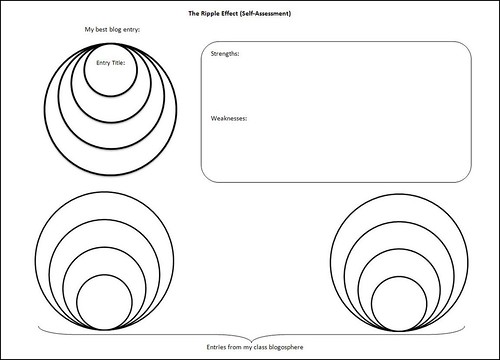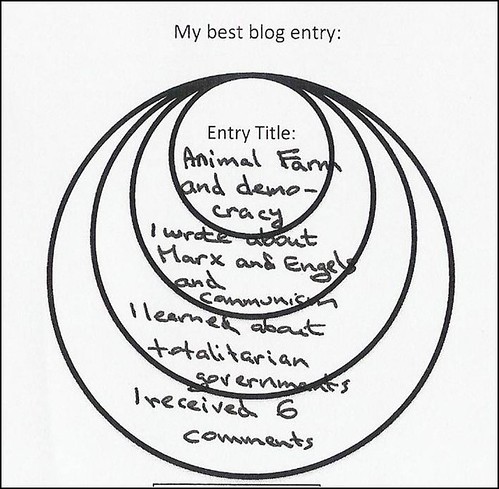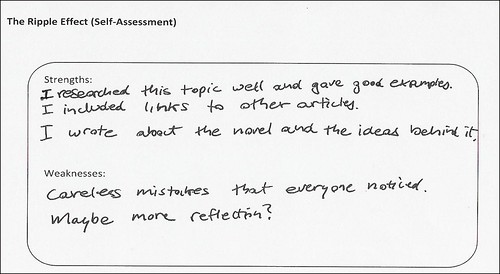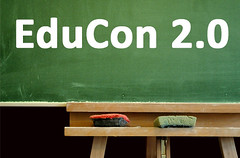Towards Reflective BlogTalk
Ever since I returned from EduCon, I've been thinking about instructional conversations. After touring the Science Leadership Academy and listening to SLA students share their views during all sessions that I attended at EduCon, I have come to believe that I need to have more conversations between myself and my students, as well as among all the students in the classroom and the class blogosphere. I think we need more blogtalk - more talk about texts.
It's not enough to know how to grow a blog, to pick a topic and keep contributing to one's blog. Our students must also be aware of the class communities in which they learn. They have to have opportunities to think and respond to other writers. They need opportunities to engage in and sustain conversations about their own work and the work of their peers. Blogging is not about choosing a topic and writing responses for the rest of the term. It is about meaningful, thoughtful engagement with ideas. But a grade eight student may need additional support to learn what it means to be thoughtfully engaged. I find that for so many of my students blogging often becomes a race to publish, to write entries and receive comments. (Most of them measure the success of their blog by the number of comments they receive, and the content of the comment is often not as important as the mere fact that it is there). They rarely look critically at their own writing, preferring instead to judge their own work by the traffic that it attracts to their blog.
Over the past couple of months I've been trying to test and implement a number of strategies to get my students more involved in their work. The first step that I take towards helping students think critically about their own work, towards engaging them as writers, consists of leaving readerly comments on their blog. The blogging platform we use makes that process easier and more transparent for the student. What I like about this platform - 21 classes - is that my comments appear in a separate space from that devoted to comments left by other students. The author of the blog can use the dashboard to quickly scan the entries where the teacher left comments. It may not be a very important feature to all teachers, but it is of significant value to me and my students because it makes conversations easier to track:
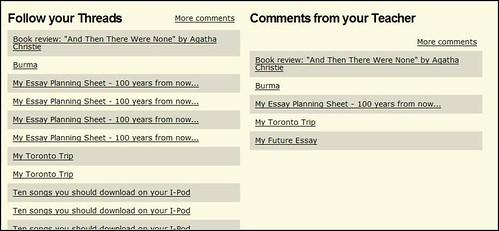 (Click for a bigger version and embedded notes)
(Click for a bigger version and embedded notes)
In my opinion, this feature encourages instructional conversations. Comments are not just an extrinsic part of having a blog - in 21classes they are presented as an integral part of the activity. The caption at the top says "Follow Your Threads" thus making it seem like there's a discussion forum attached to every blog entry. All of the links shown in the screenshot above are linked to specific entries where the comments have been posted so the students can easily follow all the comments left by their teacher. They don't have to check every single entry. All they need to do is log into their dashboard and the latest comments and the entries they are attached to will be displayed for them.
This does not mean that teacher comments are more important than those posted by the student's classmates. In fact, my doctoral research suggests that peer comments can have a stronger impact on confidence, engagement, and development of writing skills than comments left by the teacher. However, having the peer and teacher comments arranged side by side does help, I believe, in learning to see every entry as an originator of activity that can then lead to deep reflection. The students quickly learn that the same entry can generate very different responses or responses that address the same aspects of the entry but from two different points of view. For example, with the peer and student comments arranged side by side, the students see that my comment on their blossoming personal voice mirrors an entry left by a classmate who wrote that the entry was interesting and fun to read. The two comments, one left by a classmate and the other by the teacher, are indeed quite different but focus on essentially the same aspect of the entry. Seen side by side, they complement and reinforce each other. The voice of the teacher and the voice of a classmate combine to have a strong impact on the author's sense of confidence and can lead to ongoing conversations about his or her work.
Also, while I do try to assume a readerly and conversational voice when leaving comments, I also believe that my role in the classroom is to guide and support, and that the students need that specific type of teacher presence to be available to them. Having teacher comments appear in a different column makes instructional conversations easier for the students to follow and participate in.
But there’s more.
In order to engage in truly reflective thought about their work, students must also have opportunities to analyze who they are as bloggers and writers. They must have opportunities to look critically at their own work and see how they fit into the class blogosphere.
Recently, I developed a handout that helps students accomplish just that.
The Ripple Effect Sheet is designed to encourage students to become aware of the class blogosphere, of other writers, of entries that define the environment in which they write, and of their own contributions to that environment. I begin this process by asking the students to reflect on one of their own blog entries:
This handout gives students an opportunity to pick their single best blog entry and comment on how writing that entry contributed to their growth as a thinker or writer. In other words, I want them to think about the perceived ripple effect that this one specific entry - one specific topic and their subsequent engagement with that topic - had on them as individuals. How did it expand their understanding of the topic? What exactly did they learn? Was there a reaction from the class blogosphere?
Here’s a sample response:
As you can see, this handout provides a perfect opportunity to start a conversation with a student about his or her specific entry. It's a great opportunity to not only help the student reflect on what she has learned through her entry but also try to discuss the impact of the entry on other writers in the class blogosphere. For example, the six comments that Terry mentions in the Ripple Effect diagram shown above offers a good opportunity to discuss specific characteristics that made the entry appealing to his classmates - to discuss, in other words, the impact that his work had on its readers in the class blogosphere. Once Terry completed his Ripple Effect sheet, we sat down and looked closely at the six comments that his classmates left on his blog. We talked about how the depth of his work and his unique conversational style appealed to his classmates. Needless to say, it was a very empowering conversation for Terry but also one that helped him look discerningly at his work and see himself, for the very first time, as a member of a larger community of thinkers, not just a classroom where students write because they need to submit assigned work.
But the process did not end there. Having looked closely at his work and discussed some of its aspects with the teacher, Terry used the other part of the Ripple Effect sheet to assess the strengths and weaknesses of his work:
Take a look at the first comment under "Weaknesses." Terry wrote: "Careless mistakes that everyone noticed." I did not have to point out to him that his entry was filled with careless mistakes - the community of his peers did that for me. They assumed not only their readerly roles but also the role of the editor. When we sat down with Terry to talk about his work, I did not have to begin the conversation by assuming my traditional teacherly voice and pointing out typos and grammatical mistakes. Having reflected on both his own entry and the comments left by his peers, Terry himself arrived at the conclusion that careful proofreading would make his work clearer and easier to follow for his classmates.
This is a very important realization for a thirteen-year-old student. It's a realization that I could have tried to drill into his head by printing and then underlining or circling all the careless mistakes that he had made in his entry. I did not do that. But I did not abdicate my role as a teacher either. I merely adapted my presence to work within a class community of writers. In other words, I chose not to say anything. I chose not to directly address Terry's carelessness because I knew that the community I had helped create would step in and make Terry aware of this problem. Now, let's face it, there are schools out there where modifying my presence in this manner would lead some people to accuse me of being irresponsible, of not doing my job. I believe, however, that creating a community of reflection and support that the student can depend on for timely and accurate feedback that can replace, or at least complement, the role of the teacher is more important and more effective than maintaining my authoritarian voice of the expert.
The fact that Terry's realization about careless mistakes did not come from me is immensely important. Learning from his own classmates that his work, while interesting and fun to read, would become even stronger if Terry took the time to proofread and revise is much more effective as a learning tool than constant reminders from the teacher. By encouraging reflection, the Ripple Effect handout helped empower Terry and made him more aware of the strengths and weaknesses of his own work. It also provided me with an opportunity to become a conversation partner, a guide who helped Terry find the time to reflect, to evaluate, to listen to and become aware of his own voice and other writerly voices in the class blogosphere.
This awareness of other writerly voices is very important. That's why the Ripple Effect sheet provides an opportunity to reflect not only on one's own work but also on the work of other writers and their impact on the class blogosphere. Once the students get in the habit of looking critically at their own work, I also ask that they look around the class blogosphere and pick one or two entries that had impacted them in some way. Once again, I ask for a reflective response. I ask the students to describe the ripple effect that the entry or entries had on them as individuals. "What did you learn?" I ask. "How did you respond?" "How big of a ripple did this cause in your own understanding of the topic?" "Was there a ripple effect in our community?" "Did people respond? If so, how?""Did this writer help you grow as a thinker, a writer? Why? How?"
Here’s a sample response:
The response develops from a simple "Sierra Leone and Child Soldiers by Anna" to a much more complex "I realized what is happening there relates to Animal Farm (undemocratic governments)." The reason why I think this process is valuable pedagogically is because, without it, most of my students would not even be aware of the fact that Anna wrote about child soldiers. The ripple effect handout, however, forces the students to look carefully at specific entries and think about their own reactions. It gives them an opportunity to look carefully at what is happening on other blogs in the class community and then reflect on their own reactions. I want the students to realize that Anna, for example, is not just some isolated writer writing in order to get a grade, but a thoughtful, creative, and sensitive human being who is communicating ideas we can all learn from. Once Terry understands how much Anna can contribute to his understanding of the novel and current international events, he will be less likely to dismiss his class blogosphere as just a group of kids writing for school. And so, it isn't surprising that Terry's reflection does not end at the last ripple - his engagement with Anna's piece went beyond making the connection between Sierra Leone and Animal Farm - he also made a connection with the author, with Anna herself, and, as his own words indicate, he cemented that connection by leaving a comment.
I admit, this approach is still in its infancy, but it provides a valuable mechanism to engage students in reflective thinking about their work and the work of their peers. It also provides an opportunity to continue to redefine my presence in the classroom.
The point here is that when we talk about blogging, most of us focus on writing. We tend to ignore the fact that a class blogging community provides teachers with a very valuable opportunity to use informal instructional conversations to engage our students as thinkers and writers. These conversations can help our students immerse themselves in the rich tapestries of voices that characterize blogging communities.
